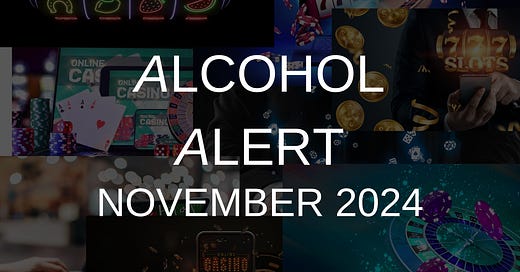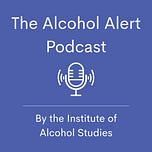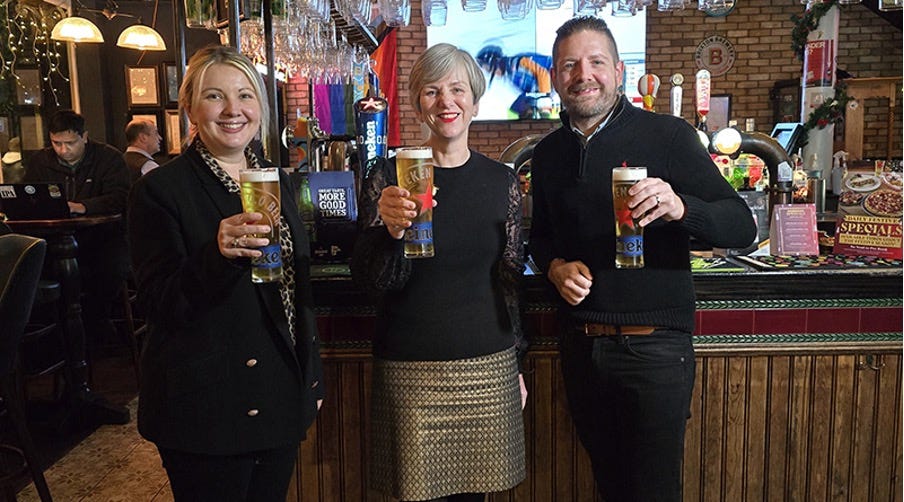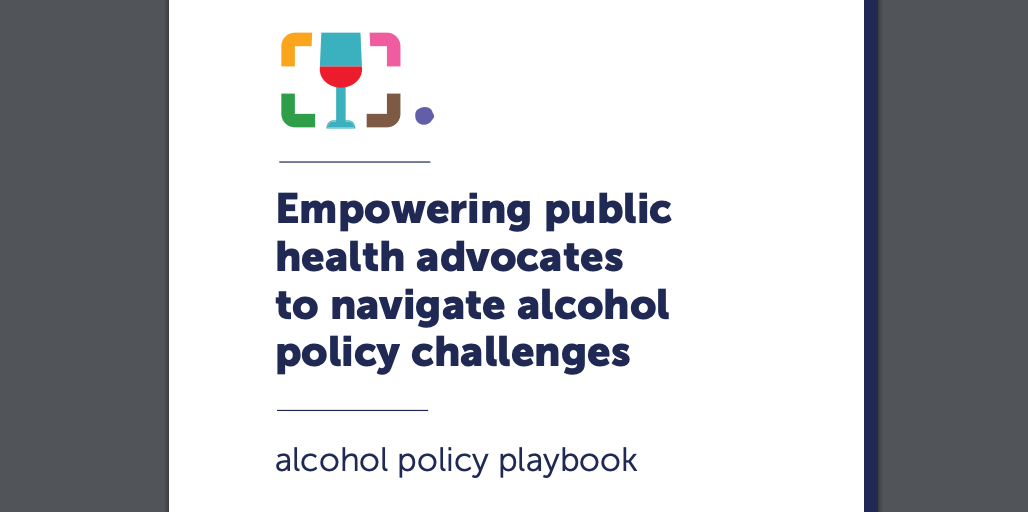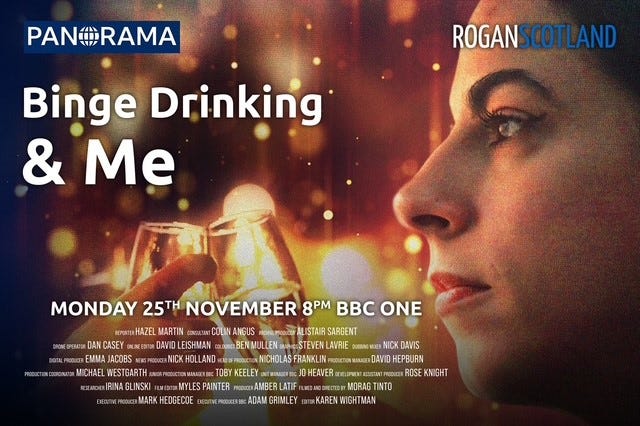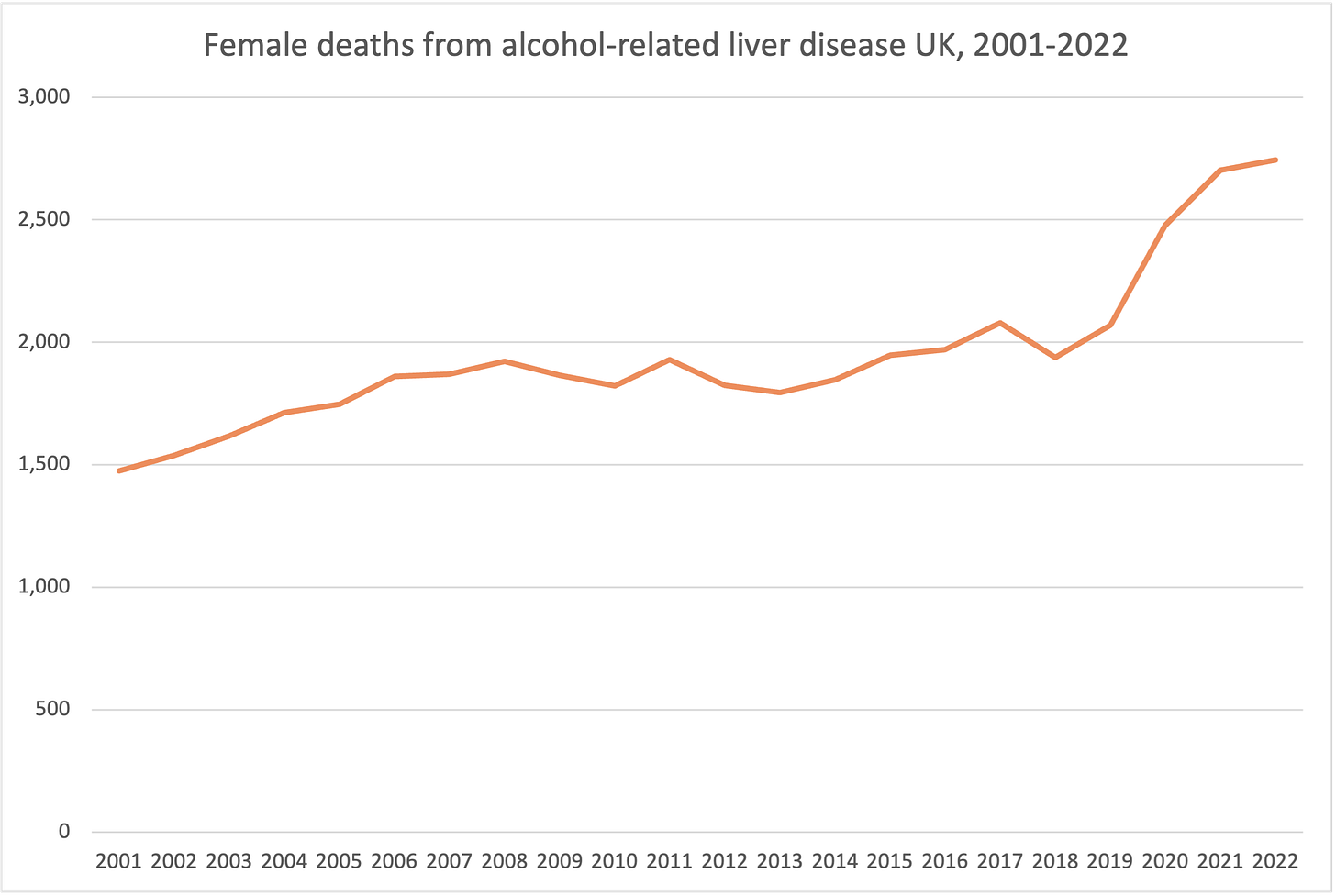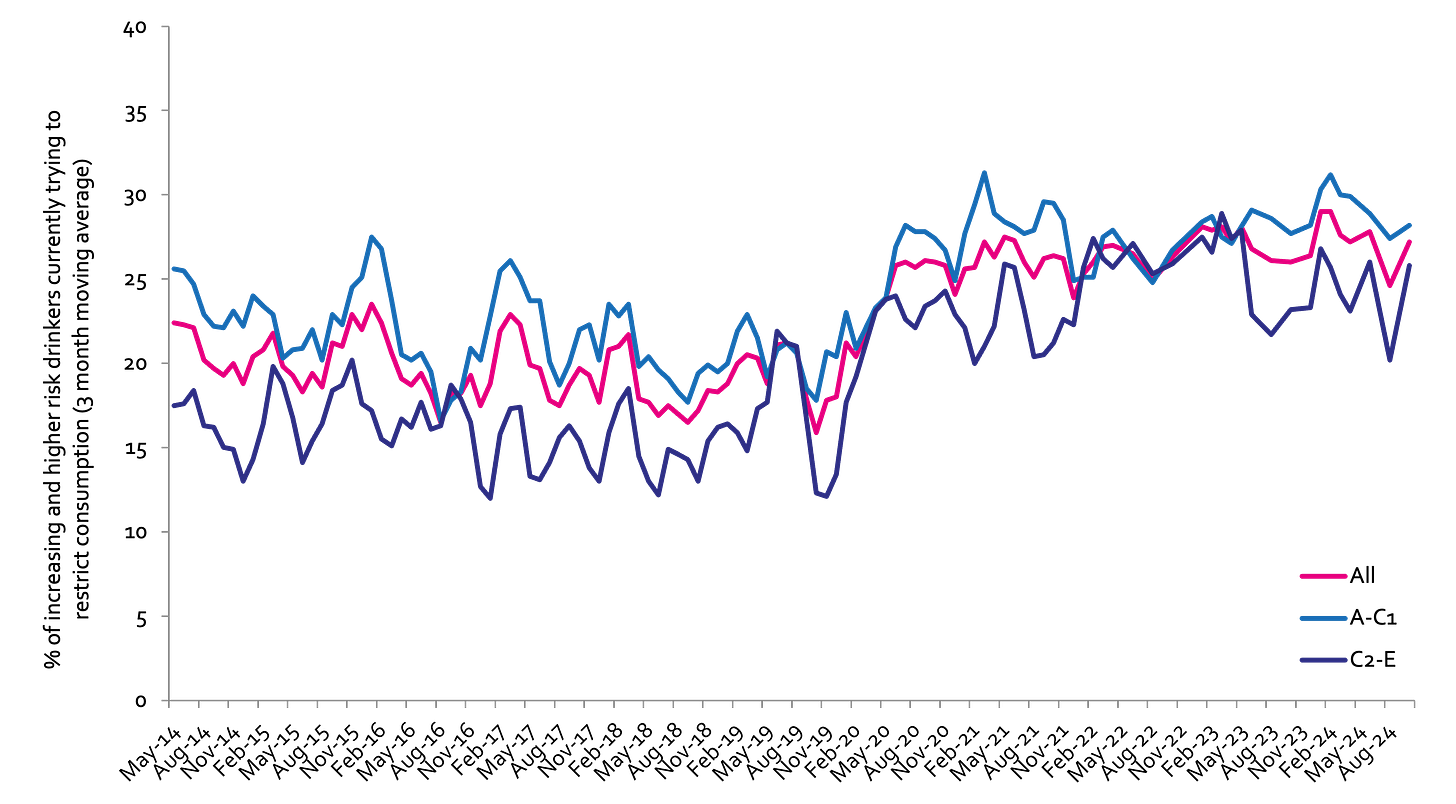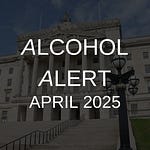Hello and welcome to the Alcohol Alert, brought to you by The Institute of Alcohol Studies.
In this edition:
IAS blogs
Gambling industry harms and parallels with the alcohol world 🎵 podcast feature 🎵
Cuts and freezes to alcohol duty will cost the Treasury £28.6 billion by 2030
Urgent action needed to tackle alcohol deaths, states the MCA
How alcohol enters and affects the brain
UK government partners with Heineken for annual drink driving campaign
The Alcohol Playbook: WHO resource to empower policymakers and public health advocates
How unhealthy industries use intimidation to hinder health advocacy
Panorama: Binge Drinking and Me
Alcohol Toolkit Study: update
We hope you enjoy our roundup of stories below: please feel free to share. Thank you.
IAS blogs
To read blogs click here.
Gambling industry harms and parallels with the alcohol world 🎵 podcast feature 🎵
In this month’s podcast we spoke to Will Prochaska, Leader of the Coalition to End Gambling Ads and former Chief Executive of the charity Gambling with Lives. We discussed:
What the gambling world looks like.
The harms associated with gambling.
Why New Labour’s liberalisation of gambling was "one of the worst things we did as a government" according to Alastair Campbell.
The many similarities in how the alcohol and gambling industries behave.
And the pros and cons of a levy on the gambling industry.
On the podcast Mr Prochaska said:
“The industry would like to present that only those people who are addicted are harmed. But actually, there are a whole host of lower level harms that aren’t given the importance they deserve.”
On a recent BBC Sunday Morning Live Debate, Mr Prochaska debated Christopher Snowdon of the Institute of Economic Affairs (IEA), highlighting that the vast majority of the public has concerns with the way gambling is marketed, and that the views of the IEA and the “wacky right” are both extreme and a minority.
On Wednesday 27 November, after our podcast recording, the government announced that it will introduce a £5 per spin limit to online slots betting for adults 25 and older, and a £2 limit per bet for 18 to 24-year-olds. Gambling minister Baroness Fiona Twycross also said that the government would introduce “the first legally mandated” tax on the betting industry, which will be used to fund research, prevention, and treatment of gambling harm. On Twitter Mr Prochaska said:
“Today's announcement of a statutory levy on gambling companies is a hard won step in the right direction, but it must mark the beginning of a full government review of gambling’s place in society.”
In related news, The Guardian published its position on gambling, arguing that with growing concern about the harms caused by the industry, “ministers deserve to come under pressure if they don’t clarify their intentions soon”.
It goes on to state that the “lack of any clear direction on restricting gambling advertising” is concerning, and that “given the digital and mobile nature of the industry, there is a powerful case for joint action by governments as well as tighter national regulations”.
Cuts and freezes to alcohol duty will cost the Treasury £28.6 billion by 2030
In our latest Budget Analysis, we found that cuts and freezes to alcohol duty since 2013 will cost the government over £28.6 billion by 2030.
In the Autumn Budget in October, Chancellor Rachel Reeves confirmed that most alcohol duty rates will go up by RPI inflation of 3.65% from 01 February 2025, making it only the third time in over a decade that most alcohol duties have kept in line with inflation.
She also increased Draught Relief, meaning that most on-trade draught products will see reduced rates from February 2025. And Reeves confirmed that the temporary wine duty ‘easement’ would end by 01 February, to bring wine duty in line with all other products.
As the Office for Budget Responsibility (OBR) and Treasury assume that all products' rates will go up by RPI, the decisions will cost the government £465 million over the next five years. This is far less than cuts and freezes have cost, which tend to be over £500 million every year. Added to the cost of previous cuts, our analysis finds that by 2029-30, the total cumulative foregone revenue will reach £28.6 billion. In other words, if the government had stuck to the planned trajectory for alcohol duty in 2012 – to increase all duties by 2% above inflation in 2013/14 and 2014/15, and maintain them in line with inflation every year thereafter – this would have raised another £28.6 billion for the public finances.
The Sheffield Addictions Research Group (SARG) has, for the first time, published a briefing report, modelling the likely impact of decisions taken on alcohol (and tobacco) duty at the Budget. Their analysis estimates that, compared with if all alcohol duty had been increased with inflation:
The extension of draught relief is estimated to slightly increase drinking, with:
2,167 more individuals drinking at increased risk levels
5,635 more at higher risk levels
7,802 fewer at lower risk levels
Over five years this leads to an estimated 1,118 additional hospitalisations and 142 additional deaths.
Alcohol duty and VAT receipts are estimated to fall by £405 million over five years.
Although increasing most products by RPI is a step in the right direction, it falls far short of undoing the damage of the past decade, with cuts and freezes significantly increasing the affordability of alcohol, contributing to an increase in alcohol consumption and subsequent harm. There are broader concerns that the Autumn Budget was Labour’s chance to make big changes across many economic and societal aspects, including alcohol duty. However, IAS is hopeful that Labour’s Health Mission and focus on prevention will necessitate a longer-term assessment of how alcohol duty decisions are made.
Therefore, IAS recommends the following:
Raise alcohol duty above inflation each year, targeting off-trade alcohol.
Develop a mechanism that ensures alcohol duty rates cover the external cost of alcohol harm to society and incentivises alcohol producers to reduce harm.
Equalise cider duty rates over time with that of beer of the same strength (ABV).
Read our full Budget Analysis here.
Cat Smith MP speech
Speaking in the House of Commons a week after the Budget, Labour MP Cat Smith called for the government to “stop placating the multi-billion-pound alcohol industry under the guise of helping pubs” and raise alcohol duty to cover the cost of alcohol harm. She also called on the frontbench to “look again at the cost of alcohol to our society and at how we address deaths from alcohol”.
You can watch her short speech here:
Urgent action needed to tackle alcohol deaths, states the MCA
The Medical Council on Alcohol (MCA) published a report yesterday on The Need for a Health System Response to Alcohol-Related Harms, which highlights the huge rise in alcohol-related deaths across the UK. It calls for urgent action to tackle this growing public health challenge, urging a coordinated health systems approach to tackle the issue.
The report calls for:
Julia Sinclair, Professor of Addiction Psychiatry at the University of Southampton and lead author of the report, said:
"This report reinforces what we already know: alcohol-related harm is a growing and preventable crisis. While alcohol consumption is often normalised in our society, the scale of its impact on health and social inequalities cannot be ignored. Now is the time to act decisively to reverse these trends, or we risk placing an even greater burden on our health system and losing more lives unnecessarily."
Responding to the report and the rise in alcohol deaths, the Liberal Democrats’ Mental Health spokesperson, Danny Chambers MP, said:
"This is both a mental health and physical health issue - but people only seem to be able to access support when their alcohol intake causes a physical health problem. We need to be able to recognise and support people through addiction before they cause serious physical harm to themselves."
The MCA report highlights that, without intervention, the increasing toll of alcohol-related harms will continue to strain health services, while limited access to treatment leaves individuals and families without sufficient support.
How alcohol enters and affects the brain
In the latest film in our Explained series, we look at alcohol’s impact on the brain, with expert analysis from Dr Anya Topiwala, Senior Researcher at the University of Oxford.
The film explains how alcohol enters the brain, the short and long-term effects and harms it can cause, and specific risks for both the developing brain and older people. For instance, a study of Swedish men found that heavy drinking as a teenager was the biggest risk factor for developing early onset dementia in later life.
Dr Topiwala and IAS conclude the film with recommendations for how to reduce the risk of harm to the brain from alcohol.
Our next two films will be on the history of alcohol treatment and alcohol industry practices in the Global South, stay tuned.
UK government partners with Heineken for annual drink driving campaign
The Department for Transport (DfT) has partnered with Heineken, Drinkaware, Fuller’s, and the British Beer & Pub Association for this year’s THINK! drink driving campaign.
The campaign, which was launched on 20 November, encourages people to ‘THINK 0%’, and includes 0% branding on pub equipment and staff T-shirts.
The Future of Roads Minister, Lilian Greenwood, launched the campaign from a pub in London Bridge by pouring a pint of 0% Heineken. In the government press release she said:
“This is a welcome campaign from THINK!, using everyday names to remind drivers of 0% options before they buy a pint.”
(Lilian Greenwood MP, middle)
James Crampton, Corporate Affairs Director at Heineken UK, said:
“When you are driving, Heineken 0.0 is the ideal alternative to your alcoholic drink. People can still be part of the round, with a pint or bottle in hand, and importantly be safe to drive – for themselves, their passengers, and other road users.”
Each year, IAS has joined public health groups in highlighting the contradiction in the UK government partnering with an alcohol giant that produces the very products responsible for drink-driving collisions. This year’s campaign gives Heineken a platform to promote its broader brand, which includes numerous alcoholic beverages. For instance, the above image contains no reference to the product advertised being 0%. IAS principles for good governance in managing interactions with alcohol industry stakeholders advise governments to reject partnerships with industry that endorse or promote corporate social responsibility or other stakeholder marketing initiatives. In a 2022 blog, Colin Shevills – the Former Director of Balance and Special Adviser to the Alcohol Health Alliance – explained why this partnership is problematic:
“It convinces governments that – despite all the evidence to the contrary – alcohol companies are part of the solution to alcohol harm, not the cause of the problem. It has convinced them that we don’t need a new alcohol strategy which tackles the affordability, availability and desirability of alcohol.
“You could argue that campaigns such as the THINK! partnership are even more important than the millions spent on brand advertising as they ward off regulation.”
Figures from the DfT show that an estimated 300 people were killed in drink driving collisions in the UK in 2022, the highest number since 2009, and a 16% increase since 2021.
The Alcohol Playbook: WHO resource to empower policymakers and public health advocates
On 08 November, the World Health Organization Europe launched its Alcohol Playbook, a resource designed for policy-makers, advocates, and public health professionals to identify and push back on alcohol industry arguments.
It addresses key questions and frequently touted myths about the impact of alcohol and the effectiveness of key policies, including on pricing, availability controls, marketing restrictions, labelling, drink-driving interventions, and regulations for no- and low-alcohol products.
Dr Katherine Severi, Chief Executive of IAS, said:
“The Institute of Alcohol Studies is proud to endorse the WHO’s new Alcohol Policy Playbook. As IAS’s good governance policy on interactions with the alcohol industry emphasises, transparency and integrity are critical to protecting public health.
“Put simply: we will not make progress on public health if the alcohol industry’s influence on policymaking is not curtailed, as was done with the tobacco industry to great success. By acting decisively with the Playbook’s guidance, UK policymakers – and politicians across the world – can prioritise public health, free from the shadow of corporate interests.
For each question, the Playbook contrasts the alcohol industry’s views with public health evidence, helping users to identify when alcohol-related issues are being framed from a commercial perspective.
Professor Sir Ian Gilmore, Chair of the AHA, said:
“To ensure decisions are made solely to reduce harm and advance public health, it is essential that policymakers are savvy to common industry arguments and are equipped to keep the alcohol industry at arm’s length. This Playbook aims to do just that, serving as an important tool for policymakers in the UK and worldwide in developing effective policies to reduce alcohol-related harm.”
How unhealthy industries use intimidation to hinder health advocacy
An article published in Health Promotion International has highlighted the issue of intimidation faced by advocates and researchers across the tobacco, alcohol, and ultra-processed food (UPF) sectors.
The most common form of intimidation was ‘public discreditation’, with researchers and advocates being publicly criticised for their work in traditional media. Discreditation often focused on undermining individuals and organisations, with researchers being labelled as “extremists,” “fascists,” “Nazis,” “zealots,” and “prohibitionists”.
Study author Karen Evans-Reeves, from the University of Bath’s Department of Health and Tobacco Control Research Group, said:
“Our hope is that shining a spotlight on these highly unethical tactics may reduce their chilling effect on improving health and help researchers and advocates understand how to pre-empt and respond.”
Professor Mark Petticrew of the London School of Hygiene and Tropical Medicine told The BMJ that:
“I know of or have experienced the discrediting of research and researchers; attempting to silence research with lawyers’ letters and coded threats; anonymous letters circulated by industry related bodies; and attempts to put pressure on journal editors.
“What is less obvious is indirect forms of intimidation. These industries and industry-funded front groups and charities also use their trustees and academic and clinical collaborators as proxies to attack the research and researchers.”
Despite these challenges, many advocates persevered, with some successfully countering intimidation through legal means or public exposure of corporate misconduct. The review calls for greater support for advocates, especially in low- and middle-income countries, where intimidation tactics are more extreme, to ensure continued progress in health policy development.
The authors write that:
“Given the similarity of intimidation experienced across the sectors, collaboration on how individuals and organizations might respond to such instances is warranted. Spreading awareness amongst colleagues is likely to be a helpful first step in this process.”
Panorama: Binge Drinking and Me
On the latest episode of BBC Panorama, which aired on 25 November, BBC journalist Hazel Martin delves into why there has been such a staggering increase in women dying from alcohol-related liver disease in recent years.
At 32, Hazel was shocked to be diagnosed with severe liver scarring, caused by years of heavy episodic drinking. In the episode, she explains that she never considered herself to be drinking at a particularly harmful level. As the British Liver Trust says:
“Hazel’s story serves as a powerful reminder that alcohol-related liver disease can develop silently, often without obvious symptoms and affecting even those who don’t drink excessively every day. Early diagnosis in crucial; in Hazel's case it was a turning point that prompted her to make the lifestyle changes her body needed to restore her liver to full health.”
Since 2003, the number of premature deaths from alcohol-related liver disease has increased by 61.3% in England, rising by 53.7% in men and 76.9% in women. Hospital admissions for the disease among women have increased by 74.8% since 2013.
In the written BBC article about the episode, Professor Fiona Measham of the University of Liverpool explains that alcohol industry marketing that targeted women in the 1990s and 2000s with products that used female empowerment and liberation contributed to establishing a drinking culture in a whole generation of young women that would leave a lasting legacy.
Professor Carol Emslie, from Glasgow Caledonian University, spoke on the show about industry marketing practices:
“A few years ago, we started a social media campaign called ‘Don’t Pink My Drink’ which was really to try to show the variety of cynical ways that women are marketed to with alcohol. I think quite often alcohol companies are very good at identifying trends or identifying what’s being talked about, but then they really magnify it. It’s very cleverly interwoven into women’s lives.
“The industry will resist to the best of their abilities any attempts to reduce the power that they have.”
Alcohol Toolkit Study: update
The monthly data collected is from English households and began in March 2014. Each month involves a new representative sample of approximately 1,700 adults aged 16 and over.
See more data on the project website here.
Prevalence of increasing and higher risk drinking (AUDIT-C)
Increasing and higher risk drinking defined as those scoring >4 AUDIT-C. A-C1: Professional to clerical occupation C2-E: Manual occupation
Currently trying to restrict consumption
A-C1: Professional to clerical occupation C2-E: Manual occupation; Question: Are you currently trying to restrict your alcohol consumption e.g. by drinking less, choosing lower strength alcohol or using smaller glasses? Are you currently trying to restrict your alcohol consumption e.g. by drinking less, choosing lower strength alcohol or using smaller glasses?
Serious past-year attempts to cut down or stop
Question 1: How many attempts to restrict your alcohol consumption have you made in the last 12 months (e.g. by drinking less, choosing lower strength alcohol or using smaller glasses)? Please include all attempts you have made in the last 12 months, whether or not they were successful, AND any attempt that you are currently making. Q2: During your most recent attempt to restrict your alcohol consumption, was it a serious attempt to cut down on your drinking permanently? A-C1: Professional to clerical occupation C2-E: Manual occupation
The UK Alcohol Alert (incorporating Alliance News) is designed and produced by The Institute of Alcohol Studies. Please click the image below to visit our website and find out more about us and what we do, or the ‘Contact us’ button. Thank you.

